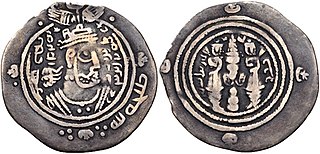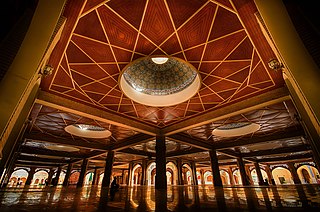
The Umayyad Caliphate or Umayyad Empire was the second caliphate established after the death of the Islamic prophet Muhammad and was ruled by the Umayyad dynasty. Uthman ibn Affan, the third of the Rashidun caliphs, was also a member of the clan. The family established dynastic, hereditary rule with Mu'awiya I, the long-time governor of Greater Syria, who became caliph after the end of the First Fitna in 661. After Mu'awiya's death in 680, conflicts over the succession resulted in the Second Fitna, and power eventually fell to Marwan I, from another branch of the clan. Syria remained the Umayyads' main power base thereafter, with Damascus as their capital.

Uthman ibn Affan was the third caliph, ruling from 644 until his assassination in 656. Uthman, a second cousin, son-in-law, and notable companion of the Islamic prophet Muhammad, played a major role in early Islamic history. During his reign as caliph, he was known for ordering the official compilation of the standardized version of the Quran that is still being used today.

Mu'awiya I was the founder and first caliph of the Umayyad Caliphate, ruling from 661 until his death. He became caliph less than thirty years after the death of the Islamic prophet Muhammad and immediately after the four Rashidun ('rightly-guided') caliphs. Unlike his predecessors, who had been close, early companions of Muhammad, Mu'awiya was a relatively late follower of Muhammad.

Marwan ibn al-Hakam ibn Abi al-As ibn Umayya, commonly known as Marwan I, was the fourth Umayyad caliph, ruling for less than a year in 684–685. He founded the Marwanid ruling house of the Umayyad dynasty, which replaced the Sufyanid house after its collapse in the Second Fitna and remained in power until 750.

Ṭāhir ibn Ḥusayn,, also known as Dhul-Yamīnayn, and al-Aʿwar, was a general and governor during the Abbasid Caliphate. Specifically, he served under al-Ma'mun during the Fourth Fitna and led the armies that would defeat al-Amin, making al-Ma'mun the caliph.

Kufa, also spelled Kufah, is a city in Iraq, about 170 kilometres (110 mi) south of Baghdad, and 10 kilometres (6.2 mi) northeast of Najaf. It is located on the banks of the Euphrates River. The estimated population in 2003 was 110,000. Currently, Kufa and Najaf are joined into a single urban area that is mostly commonly known to the outside world as 'Najaf'.

Abu al-Mughira Ziyad ibn Abihi, also known as Ziyad ibn Abi Sufyan, was an administrator and statesman of the successive Rashidun and Umayyad caliphates in the mid-7th century. He served as the governor of Basra in 665–670 and ultimately the first governor of Iraq and practical viceroy of the eastern Caliphate between 670 and his death.

The First Fitna was the first civil war in the Islamic community. It led to the overthrow of the Rashidun Caliphate and the establishment of the Umayyad Caliphate. The civil war involved three main battles between the fourth Rashidun caliph, Ali, and the rebel groups.
Abu'l-Sāj Dēvdād was a Sogdian prince, who was of the most prominent emirs, commanders and officials of the Abbasid Caliphate. He was the eponymous ancestor of the Sajid dynasty of Azerbaijan. His father was named Devdasht.
Abū ʿAbd al-Raḥmān ʿAbd Allāh ibn ʿĀmir ibn Kurayz was a Rashidun politician and general, he served as the governor of Basra from 647 to 656 AD during the reign of Rashidun Caliph Uthman ibn Affan. Through his father, he was a cousin of the Caliph. He is renowned for his administrative and military prowess, particularly for his successful campaigns of reconquest and pacification in the former territories of the Sasanian Empire, in what is now present-day Iran and Afghanistan.

The Abbasid Revolution, also called the Movement of the Men of the Black Raiment, was the overthrow of the Umayyad Caliphate, the second of the four major Caliphates in Islamic history, by the third, the Abbasid Caliphate. Coming to power three decades after the death of the Islamic prophet Muhammad and immediately after the Rashidun Caliphate, the Umayyads were an Arab empire ruling over a population which was overwhelmingly non-Arab. Non-Arabs were treated as second-class citizens regardless of whether or not they converted to Islam, and this discontent cutting across faiths and ethnicities ultimately led to the Umayyads' overthrow. The Abbasid family claimed descent from al-Abbas, an uncle of Muhammad.
The Alid revolt of 762–763 or Revolt of Muhammad the Pure Soul was an uprising by the Hasanid branch of the Alids against the newly established Abbasid Caliphate. The Hasanids, led by the brothers Muhammad and Ibrahim, rejected the legitimacy of the Abbasid family's claim to power. Reacting to mounting persecution by the Abbasid regime, in 762 they launched a rebellion, with Muhammad rising in revolt at Medina in September and Ibrahim following in Basra in November.
Abd al-Rahman ibn Muhammad ibn al-Ash'ath, commonly known as Ibn al-Ash'ath after his grandfather, was a prominent Arab nobleman and military commander during the Umayyad Caliphate, most notable for leading a failed rebellion against the Umayyad viceroy of the east, al-Hajjaj ibn Yusuf, in 700–703.
The Umayyad dynasty or Umayyads was an Arab clan within the Quraysh tribe who were the ruling family of the Caliphate between 661 and 750 and later of al-Andalus between 756 and 1031. In the pre-Islamic period, they were a prominent clan of the Meccan tribe of Quraysh, descended from Umayya ibn Abd Shams. Despite staunch opposition to the Islamic prophet Muhammad, the Umayyads embraced Islam before the latter's death in 632. Uthman, an early companion of Muhammad from the Umayyad clan, was the third Rashidun caliph, ruling in 644–656, while other members held various governorships. One of these governors, Mu'awiya I of Syria, opposed Caliph Ali in the First Muslim Civil War (656–661) and afterward founded the Umayyad Caliphate with its capital in Damascus. This marked the beginning of the Umayyad dynasty, the first hereditary dynasty in the history of Islam, and the only one to rule over the entire Islamic world of its time.
Isa ibn Yazid al-Juludi was a ninth century military commander for the Abbasid Caliphate. He twice served as governor of Egypt, from 827 to 829 and again from 829 to 830.
Abū Muḥammad Maʿdīkarib ibn Qays ibn Maʿdīkarib (599–661), better known as al-Ashʿath, was a chief of the Kinda tribe of Hadhramawt and founder of a leading noble Arab household in Kufa, one of the two main garrison towns and administrative centers of Iraq under the Rashidun (632–661) and Umayyad (661–750) caliphs.

ʿAbd Allāh ibn Khāzim al-Sulamī was the Umayyad governor of Khurasan between 662 and 665 and again in late 683, before becoming the nominal Zubayrid governor of the same province between 684 and his death.
Sa'id ibn Qays al-Hamdani was a governor and commander during the reigns of caliphs Uthman and Ali and a tribal chief of the South Arabian Hamdan and Himyarite tribesmen of Kufa during this period and under the first Umayyad caliphs.
Zutt Rebellion was a rebellion by the Zutt (Jats) between 810 and 835 in Iraq during the reign of al-Ma'mun and continued to the era of al-Mu'tasim.
Zutt is an Arabicised form of Jat. Originally inhabitants of lower Indus Valley, Jats were present in Mesopotamia from the 5th century AD since the times of the Sasanian Empire, although their main migration occurred after the establishment of Umayyad Caliphate. They were one of the prominent ethnic groups in lower Iraq during the Islamic Golden Age, supplying mercenary soldiers to the Muslim states. Their mention fades from Arab chronicles after the 11th century.









